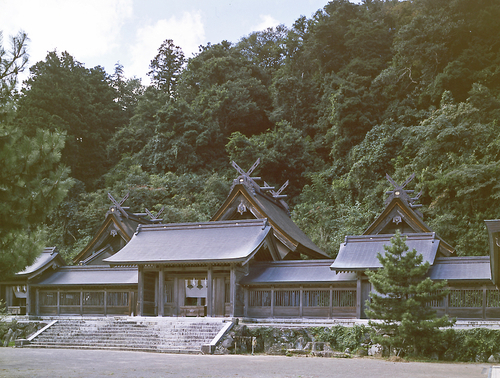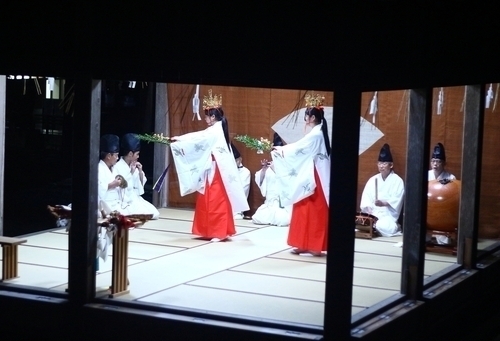Sadajinja
| Bay Name | ||
|---|---|---|
| Shrine Name | sada-jinja | |
| Deity |
(Main Hall) Sada-no-Ookami Izanagi-no-mikoto Izanami-no-mikoto Hayatamao-no-mikoto Kotosakao-no-mikoto (North Hall) Amaterasu-Ookami Ninigi-no-mikoto (South Hall) Susano-o-no-mikoto Four Secret Kami |
|
| Location |
|

This very old shrine is in the Fudoki, listed as Sada Ookami-no-yashiro or Sada Miko-no-yashiro. Structurally, it has a Main Hall, a Naorai (eating/drinking following a ceremony) Hall, a Kagura Hall, a Shrine Gate and numerous small auxiliary shrines. The enshrined deities in the Main Hall are Sada Ookami, Izanagi-no-mikoto, Izanami-no-mikoto, Hayatamao-no-mikoto and Kotosakao-no-mikoto. In the North Hall, Amaterasu-Ookami and Ninigi-no-mikoto and in the South, Susanoo-no-mikoto and the Four Secret Kami .The main god or kami is Sada-no-Ookami (also known as Saruta Hiko-no-Ookami) who was born in Kakanokukedo facing out onto the Sea of Japan. He is the kami of guidance, roads, traffic and sea safety and long life. In the time of Emperor Seiwa in the Jogan Era (859-877) he was promoted to Jushinoge (Junior Forth Rank, Lower grade). At a later date during the reign of Grand Emperor Gotoba, the shinryou (estate on which the shrine was built which provides financial support) had the capacity to produce 17250kg of crops with 224 Shinto Priests in attendance. The shrine is listed in the Engishiki as Sada-Taisha the ‘Number Two’ ranked shrine in Izumo.

Sada-jinja, the second highest ranked shrine in Izumo, is enshrined in the North of Matsue City in Sadakunai, Kashima-cho.
In the Fudoki, it is listed as Sada Ookami-no-yashiro or Sada Miko-no-yashiro. The main hall is built in the ‘taisha zukuri’ style and consists of three halls lined up alongside each other. This style of structure appears to have first been constructed at the end of the middle ages.
The current main building was constructed during the Bunka Period but its style appears to be more in following with the Genki Era.
Its halls are designated Important Cultural Properties. 12 deities are enshrined in the halls but the main god is Sada-no-Ookami (also known as Saruta Hiko-no-Ookami) who was born in Kakanokukedo facing out onto the Sea of Japan. He is the kami of guidance, roads, traffic and sea safety and long life.
The main festival, Sadasanban-no-mai, on May 3rd is a Lion Dance Naorai (eating and drinking) ceremony. The Gozakae-shinji ceremony is held over two days on September 24th and 25th with the Sada Shinou performance on day two. This is designated as a Unesco World Intangible Cultural Heritage. November 20-25 sees the assembly of the myriad gods during the Kamiarizuki with the appearance of the Ryuuja (sea snake) to guide them into Izumo from all over Japan. Ryuuja is worshipped as the kami who protects against disasters such as fires and floods and who brings good trade, harvest and prosperous fishing hauls.
| Bay Name | ||
|---|---|---|
| Shrine Name | sada-jinja | |
| Deity |
(Main Hall) Sada-no-Ookami Izanagi-no-mikoto Izanami-no-mikoto Hayatamao-no-mikoto Kotosakao-no-mikoto (North Hall) Amaterasu-Ookami Ninigi-no-mikoto (South Hall) Susano-o-no-mikoto Four Secret Kami |
|
| Location |
|
This very old shrine is in the Fudoki, listed as Sada Ookami-no-yashiro or Sada Miko-no-yashiro. Structurally, it has a Main Hall, a Naorai (eating/drinking following a ceremony) Hall, a Kagura Hall, a Shrine Gate and numerous small auxiliary shrines. The enshrined deities in the Main Hall are Sada Ookami, Izanagi-no-mikoto, Izanami-no-mikoto, Hayatamao-no-mikoto and Kotosakao-no-mikoto. In the North Hall, Amaterasu-Ookami and Ninigi-no-mikoto and in the South, Susanoo-no-mikoto and the Four Secret Kami .The main god or kami is Sada-no-Ookami (also known as Saruta Hiko-no-Ookami) who was born in Kakanokukedo facing out onto the Sea of Japan. He is the kami of guidance, roads, traffic and sea safety and long life. In the time of Emperor Seiwa in the Jogan Era (859-877) he was promoted to Jushinoge (Junior Forth Rank, Lower grade). At a later date during the reign of Grand Emperor Gotoba, the shinryou (estate on which the shrine was built which provides financial support) had the capacity to produce 17250kg of crops with 224 Shinto Priests in attendance. The shrine is listed in the Engishiki as Sada-Taisha the ‘Number Two’ ranked shrine in Izumo.
Sada-jinja, the second highest ranked shrine in Izumo, is enshrined in the North of Matsue City in Sadakunai, Kashima-cho.
In the Fudoki, it is listed as Sada Ookami-no-yashiro or Sada Miko-no-yashiro. The main hall is built in the ‘taisha zukuri’ style and consists of three halls lined up alongside each other. This style of structure appears to have first been constructed at the end of the middle ages.
The current main building was constructed during the Bunka Period but its style appears to be more in following with the Genki Era.
Its halls are designated Important Cultural Properties. 12 deities are enshrined in the halls but the main god is Sada-no-Ookami (also known as Saruta Hiko-no-Ookami) who was born in Kakanokukedo facing out onto the Sea of Japan. He is the kami of guidance, roads, traffic and sea safety and long life.
The main festival, Sadasanban-no-mai, on May 3rd is a Lion Dance Naorai (eating and drinking) ceremony. The Gozakae-shinji ceremony is held over two days on September 24th and 25th with the Sada Shinou performance on day two. This is designated as a Unesco World Intangible Cultural Heritage. November 20-25 sees the assembly of the myriad gods during the Kamiarizuki with the appearance of the Ryuuja (sea snake) to guide them into Izumo from all over Japan. Ryuuja is worshipped as the kami who protects against disasters such as fires and floods and who brings good trade, harvest and prosperous fishing hauls.






